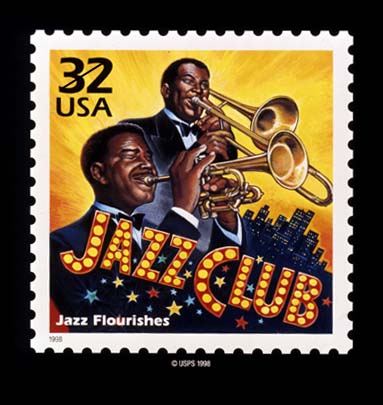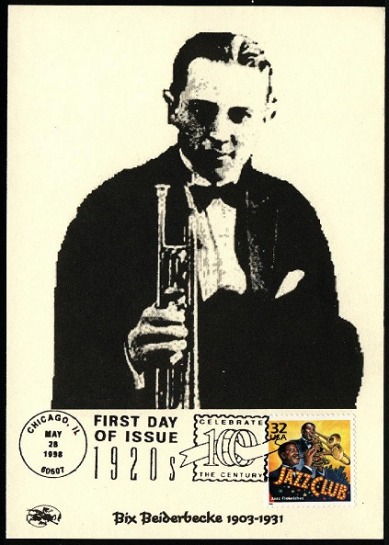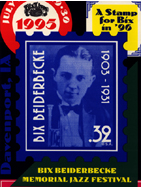A First Day Cover For Bix.
According
to the American First Day Cover Society, http://www.afdcs.org/,
"A First Day Cover (FDC) is an envelope or card bearing a stamp which is
cancelled on the day the stamp is initially placed on sale by the postal
authorities." A First Day of Issue card or envelope has the stamp and the
cancellation, e.g.,  the
date and location. A First Day Cover has, in addition, a cachet, an image
related to the subject of the stamp. The U.S. Postal Service designates
one or more cities as "official. " These are the locations where
the new stamp is first released. First Day Covers are prepared by stamp
dealers or by individuals.
the
date and location. A First Day Cover has, in addition, a cachet, an image
related to the subject of the stamp. The U.S. Postal Service designates
one or more cities as "official. " These are the locations where
the new stamp is first released. First Day Covers are prepared by stamp
dealers or by individuals.
"Celebrate the
Century" stamps were issued for every decade of the 20th century. The 1920s
decade, the roaring twenties, had fifteen stamps, some of which were related
to jazz : a flapper, a radio, and the "Jazz Flourishes" stamp. These stamps
were issued on May 28, 1998, in Chicago, Illinois. The
description of the stamp in the U.S.P.S. web site reads: “1920’s: Jazz.
Created in the United States, jazz was spread by radio and recordings in
the 1920’s. Among the leading performers were Louis Armstrong, Jelly Roll
Morton, Joe “King” Oliver, Fletcher Henderson, and Bix Beiderbecke.”
In connection
with the issue of the Jazz Flourishes stamp, Lloyd A. de Vries - a staff
member of the Virtual Stamp Club and producer of the Dragon First Day Cover
cards- prepared a card with a cachet of Bix Beiderbecke. It is shown
below.

A Commemorative Stamp for Bix.
Previous Attempts.
On January 20,
1995, Margaret Baumann, Secretary/Director of the Bix Beiderbecke Memorial
Society wrote a letter of inquiry to the Citizens Stamp Advisory Committee
of United States Postal Service in which she stated "we wish to promote
a "Stamp for Bix in '96" (note that I am paraphrasing this nice motto as
the title of the present web page) to further perpetuate the legend of
one of the great white jazz musicians". Margaret requested information
about application procedures. She received a rather non-informative answer
in which she was appraised of the fact that "the subject you proposed is
before the Citizen's Stamp Advisory Committee and remains under consideration."
Moreover, she was told that "Proponents are not advised if a subject has
been approved for issuance. A public announcement is made approximately
six months prior to the year in which the stamp will be issued."
The Society
put a great effort in promoting "A Stamp for Bix in '96" at the 1995 Festival.
The theme of the Festival for 1995 was "Bix: The Chicago Years".  However,
the poster featured the statement "A Stamp for Bix in '96" and a facsimile
of a 32-cent stamp with a photo of Bix (see the image on the right). Signatures
in support of the Bix commerative stamp were solicited at several functions
(Bix Birthday Bash in Davenport, Tribute to Bix in Libertyville and the
Bix Beiderbecke Memorial Jazz Festival) between March 1995 and August 1995.
A total of 1,792 signatures were collected and sent to the Citizens Stamp
Advisory Committee. Unfortunately, the effort was unsuccessful.
However,
the poster featured the statement "A Stamp for Bix in '96" and a facsimile
of a 32-cent stamp with a photo of Bix (see the image on the right). Signatures
in support of the Bix commerative stamp were solicited at several functions
(Bix Birthday Bash in Davenport, Tribute to Bix in Libertyville and the
Bix Beiderbecke Memorial Jazz Festival) between March 1995 and August 1995.
A total of 1,792 signatures were collected and sent to the Citizens Stamp
Advisory Committee. Unfortunately, the effort was unsuccessful.
Evidently, other
individuals have proposed Bix as the subject of a commemorative stamp.
The answer of the USPS to Margaret clearly shows that Bix was being considered.
There is additional information. On May 10, 1994, James A. Leach, member
of Congress for the first district of Iowa, wrote to the postmaster General
a letter in which he stated "It was with great joy that I learned of the
consideration of a stamp honoring Bix as part of the U.S.P.S.' musical
series. Please note my strong support of such action." In response to his
letter, Congressman Leach received a letter from the USPS in which it was
stated "A stamp honoring Bix Beiderbecke is now under consideration by
the committee." I understand that Phil Evans, himself a postal worker,
had sent in a nomination at some time.
I am grateful to Rich Johnson,
Bix Beiderbecke Festival Music Director, for sending me copies of the material
in the Society's files about their effort to secure "A Stamp for Bix in
'96". I also thank him for his support of the current attempt.
A New Effort.
A few months
ago, Mike Heckman asked me what had been done about a commemorative stamp
for Bix and suggested that a new attempt was in order. I heartily agreed
with him and we started composing a letter of nomination. We consulted
the USPS web site to find out about guidelines. The USPS established a
set of criteria
for commemorative stamp subject selection.
The criteria are quite stringent and I understand that the members of the
Citizen's Advisory Committee are a rather independent bunch. We believe
that our petition adheres closely to the criteria and we are optimistic.
A copy of the nomination and supporting material mailed on November 24,
1999 follows. We need the help of all the Bixophiles from around the world.
Please send your letters in support of our nomination to
Citizen's Stamp Advisory Committee
c/o Stamp Management
U.S. Postal Service
475 L'Enfant Plaza, SW, Room 4474EB
Washington, DC 20260-6756
IT IS NOT TOO EARLY. ACCORDING TO THE USPS, NOMINATIONS FOR COMMEMORATIVE STAMPS MUST BE SUBMITTED THREE YEARS BEFORE THE DESIRED DATE OF ISSUE.
Please write to me at ahaim@hotmail.comif you are sending an endorsement to the USPS.
Copies of the Material Submitted
to the USPS.
Michael B. Heckman
Albert Haim
P. O Box 644
20 Three Village Lane
Pine Bush, NY 12566
Setauket, NY 11733
November 19, 1999
Citizens' Stamp Advisory Committee
c/o Stamp Management,
U.S. Postal Service
475 L'Enfant Plaza, SW, Room 4474EB,
Washington, DC 20260-6756
Dear Members of the Advisory Committee:
In May 1998, the U.S.P.S issued
a commemorative stamp entitled “Jazz Flourishes”. The description of the
stamp in the U.S.P.S. web site reads: “1920’s: Jazz. Created in the United
States, jazz was spread by radio and recordings in the 1920’s. Among the
leading performers were Louis Armstrong, Jelly Roll Morton, Joe “King”
Oliver, Fletcher Henderson, and Bix Beiderbecke.” The USPS singled
out five musicians out of the hundreds who played in the 1920’s. Of these
five musicians, two of them, Louis Armstrong and Jelly Roll Morton, have
been the subjects of commemorative stamps. We suggest that Leon Bix Beiderbecke,
one of the most important American jazz musicians of the century, be honored
with a commemorative stamp to be issued on March 10, 2003, the 100th
anniversary of his birth.
Leon Bix Beiderbecke was a
jazz musician of world renown who made unparalleled, innovative, and lasting
contributions to the jazz idiom, both as a performer (cornet and piano)
and as a composer. Bix is ordinarily categorized as a jazz musician. That
would be an accurate but superficial description. What Bix created was
music of unique beauty. Jazz was the medium of his expression, but the
music that came from his cornet and piano was comparable to lyric poetry.
He took the brash, extroverted art of jazz and showed that jazz can be
melodious and reflective. He is credited with being an originator of the
jazz ballad. He took the polyphonic New Orleans jazz style and added the
expressive and lyrical instrumental solo to it. These two innovations are
among the most important components of Bix’s enduring musical legacy. The
other components are represented by Bix’s highly original musical compositions
and by his recordings. The recordings, although made when the quality of
sound reproduction was somewhat limited, show that Bix’s cornet sound was
beautiful and unique, that he was a musician of exquisite taste, and that
he had a remarkable genius for extemporaneous and highly original improvisation.
Leon Bix Beiderbecke was born
on March 10, 1903 in Davenport, Iowa and died in Queens, NY on August 6,
1931. He began his professional career in 1923 playing cornet with
the Wolverine Orchestra. In 1926, he joined the Jean Goldkette Victor Recording
Orchestra, the most successful jazz organization in the Midwest. In 1927,
he joined the orchestra of Paul Whiteman, the “King of Jazz”. During Bix’s
brief recording career – it lasted only six years – he recorded with such
jazz giants as Hoagy Carmichael, Jimmy and Tommy Dorsey, Benny Goodman,
Gene Krupa, Eddie Lang, Joe Venuti, and many others. Today, nearly 100
years after his birth and almost seventy years after his death, Bix Beiderbecke
has a phenomenal popularity and influence that extends beyond any geographical
boundaries.
Bix was an original. His technique
and style of playing were unique and had a profound influence on his fellow
musicians. Bix’s solo in “Singin’ the Blues” has been recorded note for
note by several musicians of renown such as Rex Stewart and Bobby Hackett.
Following Bix’s recording of the tune, almost every jazz player in America
tried to emulate his style and sound. Bix’s recording of “Singin’ the Blues”
is considered by most jazz critics and historians to be one of the two
most important jazz recordings of all time. The other one is Armstrong’s
“West End Blues”.
However, even more important than Bix’s influence
on his contemporaries, is the fact that he provided a different path than
that developed by Louis Armstrong. A comparison with Armstrong, considered
by many to be the most important jazz musician of the century, is appropriate
because Bix’s musical creativity flourished at the same time as that of
the young Louis Armstrong. Whereas Armstrong’s strength was his spectacular
technique, Bix’s genius was for extemporaneous improvisation. Bix’s improvisational
style introduced into jazz music a greater measure of classical structure
and sensibility. His piano compositions blend the idiom of jazz with the
classical European tradition, in particular French impressionism.
Bix’s influence in jazz was
long lasting. Many jazz critics and historians consider that Bix’s music
is at the origin of the movement known as cool jazz. Approximately one
third of the nearly fifty existing recordings of “In A Mist”, Bix’s most
important composition, were made in the 1990’s. Two jazz festivals totally
dedicated to the preservation and dissemination of Bix's musical legacy
take place every year.
Detailed information is provided
in the attached documents entitled “Additional Information in Support of
the Nomination of Leon Bix Beiderbecke as the Subject of a Commemorative
Stamp”.
Sincerely,
Michael Heckman Albert Haim
Additional Information in Support of the Nomination
of
Leon Bix Beiderbecke
as the Subject of a Commemorative Stamp
In what follows, we will list
evidence of the recognition and honors bestowed upon Bix in recognition
of his seminal contributions and achievements.
Additional letter to the Committee
Albert Haim
20 Three Village Lane
Setauket, NY 11733
February 22, 2002
Citizens' Stamp Advisory Committee
c/o Stamp Management,
U.S. Postal Service
475 L'Enfant Plaza, SW, Room
4474EB,
Washington, DC 20260-6756
Dear Members of the Advisory Committee:
On November 19, 1999, Michael Heckman
and I submitted a latter of nomination of Leon Bix Beiderbecke as the subject
of a commemorative stamp to be issued on March 6, 2003, the 100th anniversary
of his birthday.
I recently became aware of two important pieces of information in support of our nomination. In our previous letter, we highlighted Bix’s cornet solo in the recording of “Singin’ the Blues” by Frank Trumbauer and his orchestra and Bix’s piano solo recording of his own composition “In A Mist.” We discovered strong supporting evidence for the seminal importance of the two recordings.
The Grammy organization has several types of awards. One of these is the "Grammy Hall of Fame Award." As described in the grammy.com website, "The GRAMMY Hall of Fame was established by the Recording Academy's National Trustees in 1973 to honor early recordings of lasting, qualitative or historical significance that were released more than 25 years ago. Winners are selected annually by a special member committee of eminent and knowledgeable professionals from all branches of the recording arts." Two of the entries in the list of awards read as follows.
SINGIN' THE BLUES
Inducted 1977
Frankie Trumbauer And His Orchestra
Featuring Bix Beiderbecke On Cornet
Okeh
Jazz
1927
IN A MIST (Piano Solo)
Inducted 1980
Bix Beiderbecke
Okeh
Jazz
1927
An additional piece of information must be brought up to recognize the significance of the two Grammy Hall of Fame Awards. Bix Beiderbecke’s recording career covered the years 1924-1930. During that period, six records in the jazz genre were honored. Two of these are Bix’s. Clearly, the induction of the recordings “Singin’ the Blues” and “In A Mist” to the Grammy Hall of Fame bolsters our contention of the seminal importance of the contributions of Bix Beiderbecke to our American musical legacy.
Sincerely,
Albert Haim
Added January 11, 2003.
The USPS decided not to issue a stamp to commemorate
Bix's musical genius. In response to this tremendous injustice, Brad Kay
issued his own Bix stamp. It is very beautiful.

Through His Music, Bix Is
Alive
![]()
BRIEF TABLE OF CONTENTS
Recordings
The
Original 78's
Analysis
of Some Recordings: Is It Bix or Not ?
Complete
Compilations of Bix's Recordings
Tributes
to Bix
Miscellaneous
Recordings Related to Bix
In
A Mist